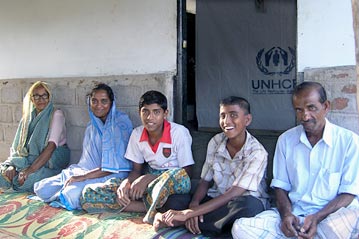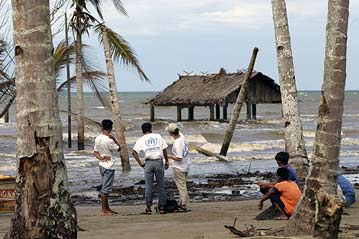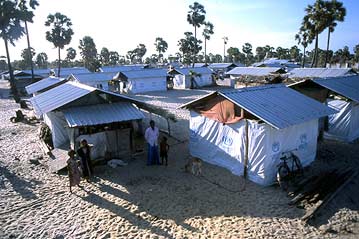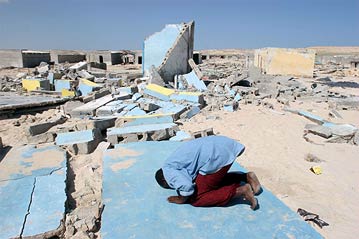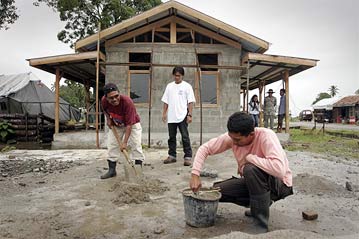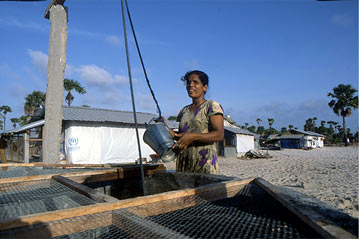Sri Lankan tsunami survivors paint the town red ... and purple, and blue
Sri Lankan tsunami survivors paint the town red ... and purple, and blue
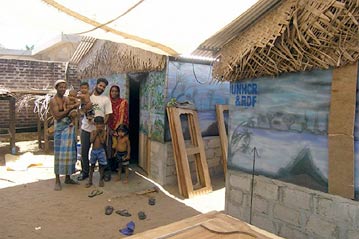
COLOMBO, Sri Lanka, October 25 (UNHCR) - Like so many other people in Sri Lanka, Mrs. A.L. Sulahaummah will never forget 26 December 2004, the day the tsunami struck, killing more than 200,000 people in 13 countries, including Sri Lanka, Indonesia, Thailand, the Indian-owned Andaman Islands, India itself, and even far-away Somalia.
Sitting outside her yellow and purple home in Kalmunai, in Ampara District, on the eastern side of the island, Mrs. Sulahaummah said she had no time to collect her possessions before running upstairs with her three children when the tsunami came. In a few seconds, the huge waves stormed some 500m inland. "We heard people crying out and saw them running from the sea. Then we went upstairs as quickly as we could," she recalled. "Our house was very badly damaged, but at least we survived."
Her new home is neither temporary, nor permanent - in aid-speak it is called a "transitional shelter" - and was given to her by the UN refugee agency. The vibrant colours, however, are entirely her own choice.
The sheer ferocity of the tsunami is almost impossible to imagine for those who did not witness it first-hand. The ten-metre-high palm trees that lined the shore, and are still upright, stand like silent memorials to the deadly wave, their leaves brown - killed by the salt water that engulfed them. Behind the trees scattered stones mark the scant remains of the buildings that bore the full force of the wave and were razed to their foundations.
But go a little deeper inland, and you will find Mrs. A.L. Sulahaummah and others like her, and the mood lightens a little, despite the awful memories of that fateful morning ten months ago.
On October 14, a small ceremony was held in Ampara District, as UNHCR handed over the keys to Mr. S.M. Adam Bawa and his family - recipients of the 2000th transitional shelter constructed by UNHCR and its partners in Ampara. As of 25 October, only 134 of the total of UNHCR 2,800 shelters planned for Ampara remained to be completed. In all, these should provide safe, sound and relatively dignified accommodation for up to 14,000 people made homeless by the tsunami.
Transitional shelters are precisely that: more than temporary, less than permanent. They are necessary because reconstruction on such a scale - tens of thousands of new permanent houses and apartments - will take several years: far too long to remain under temporary shelter such as tents in a hot country which has an annual monsoon season and is prone to storms.
UNHCR's transitional shelters measure 12 x 16 feet (3.7 x 4.9 metres) and consist of two rooms, built within a galvanized iron frame. They are compliant with the internationally-recognized SPHERE standards for a family of five. The brick foundations provide a strong and solid base. The upper walls are made of plywood, and the roofs of zinc aluminium. Although more expensive than tin, zinc aluminium is also more heat-resistant - an important factor in a hot climate.
Perhaps the most immediately striking element of the transitional shelters in Ampara District, however, are the range of bright, cheerful colours which the beneficiary families have chosen to decorate their new homes. Mrs. Sulahaummah claims she was the pioneer with her decision to go for purple and yellow.
In a year or two, she plans to use government grants to rebuild her old damaged house, which stands next to her colourful new shelter. But she shows little sign of impatience.
"I am very happy living here now, and love this house," she said, smiling and tapping the wall. "We wanted to paint it happy colours, and now everyone else is copying us!" She pointed at a bright green transitional shelter close to her own, and laughed.
Around 50 families live in this area of Kalmunai, which is imbued with a real community spirit. All around, people are working together to clear away rubble and reconstruct ruined houses. Small shops are open, selling fruit and vegetables. A sense of positive momentum fills the air.
Jo da Silva, UNHCR's outgoing Senior Shelter Coordinator in Sri Lanka, believes that the choice of colours reveals more than a mere desire for decoration. It is a way of personalizing the building and as such reflects a desire to look to the future, rather than dwell on the death and destruction wrought by the tsunami. "You can see so visibly the way that the beneficiaries have taken ownership of their shelters and even painted them bright colours and added porches, and when you interview them they really are genuinely happy," she said shortly after leaving Sri Lanka at the end of her assignment.
From the outset, UNHCR realized it was important to keep communities together. This was achieved by identifying available private land located close to, or within, affected areas that could be used for building transitional shelters.
"While logistically it has been much more complicated to construct our shelters on small plots of private land, rather than a large shelter site, there are many advantages to keeping displaced communities in familiar surroundings," said Edward Benson, Head of the UNHCR office in Ampara. He pointed out that the fact that in June his agency constructed 300 transitional shelters in Ampara on no fewer than 270 different sites illustrated the challenge presented by this community-friendly policy.
UNHCR, which set up its transitional shelter operation in Ampara in February (after the initial emergency phase was over), began with a 42-shelter pilot project. During this important initial stage, the agency's shelter specialists worked closely with the beneficiaries, and incorporated their feedback into the construction of the subsequent transitional shelters. As a result, alterations were made to the standard design, including adding cadjan on the gable ends to keep out the rain; replacing rear doors with lockable windows; and using solid timber, rather than plywood, for the doors.
"Perfecting our original design through the pilot project has ensured that the shelters effectively meet the needs of beneficiaries," Benson explained.
UNHCR will complete its transitional shelter work in Sri Lanka by the end of 2005, having built around 4,400 shelters - 2,842 in Ampara and another 1,558 in Jaffna - and actively supported the government in coordinating the provision of over 55,000 shelters island-wide. The 4,400 UNHCR shelters will accommodate up to 22,000 people, whose houses were damaged or destroyed. Nationwide, more than 200,000 people in all should benefit from the transitional shelter programme.
As lead agency in Ampara, which was the worst-affected district in Sri Lanka, UNHCR coordinated the work of over 40 shelter actors, who have constructed a total of more than 17,000 transitional shelters, Benson said. UNHCR itself constructed 2,500 of them. Although the actual construction is now virtually complete, shelter work in Ampara will continue in the form of upgrading before the start of the monsoon season at the end of the year.
With 95 percent of transitional shelter needs met nationwide, the focus is now beginning to shift to 'care and maintenance' throughout all the tsunami-affected parts of island, according to Richard Dietrich, da Silva's successor as UNHCR Shelter Coordinator. "To ensure that these transitional shelters remain an adequate interim housing solution, ongoing care and maintenance is essential," said Dietrich.
"Apart from maintaining a sustainable infrastructure, this will involve ensuring effective site management, access to basic services, such as water and sanitation facilities, schools and medical care and other issues cutting across sectors such as protection or access to reliable information," he added.

One of the most poignant transitional shelters in Ampara belongs to Hamsa, his wife Junaitha, and their five children. On the interior wall, Hamsa has painted a beautiful mural for his family, and a UNHCR logo on the outside. "We lost three of our children in the tsunami, and all of us were so unhappy," he said. "I could see the sadness on the faces of my children every day, so I decided to paint the mural to cheer them up."
Pointing enthusiastically at the various birds and elephants depicted in the mural, the young children evidently take great enjoyment from the painting. As with Mrs. Sulahaummah, to some extent it seems the house, and the paintings, have helped Hamsa and his family to look towards the future, instead of becoming mired in memories of the terrible day when some of the children survived, but three of their siblings died.
By Lyndon Jeffels in Colombo, Sri Lanka


